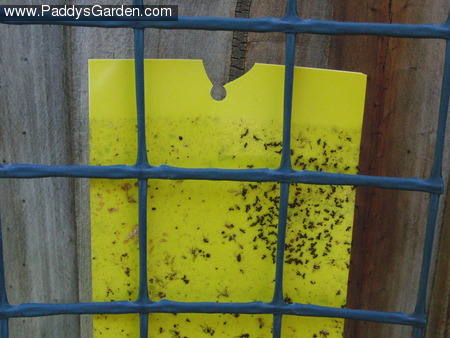Whitefly or Whiteflies are exactly like they sound. They’re tiny little moths and are hard to see unless they are in a group or swarming.
We completely fumbled the handling of our Whitefly outbreak. Where you are supposed to act early, we acted late.
The tomatoes, mint and basil all suffered heavily, with the mint becoming so stressed it never really recovered.
What we know now is that Whitefly lay their eggs on the undersides of the new growth on plants, mostly the leaves. This didn’t seem to harm the plants initially and lulled us into a false sense that the Whitefly weren’t so bad. But when the Whitefly eggs hatched the results were devastating
The young Whiteflies ate most of the leaves and what was left of the plant seemed to be poisoned from their waste.
We mixed up some Garlic Fire which when sprayed on the undersides of all the leaves and it did seem to kill the remaining eggs the process also dislodged the adult Whiteflies to another plant.
The Whiteflies seemed to be on the run and daily application of the Garlic Fire did seem to be keeping them in check. It didn’t seem to be stopping them though and it was only through some scouting around in the garden we found their roost. They seemed to love a particular type of weed that was growing in the back of the garden. We carefully plucked it (so as not to disturb many of the adult Whiteflies) and then buried the whole thing, hoping the Whiteflies can at least add something back to the garden.
With the bulk of the Whiteflies 6 inches underground and the eggs covered in Garlic Fire the we though the worst of the plague was over but they were still around and we were still consuming some serious amounts of Garlic Fire keeping them at bay.
Realising that we couldn’t keep up the Garlic Fire production we did some more searching on the web that led us to the sticky yellow moth traps that you can make or buy.
We bought a single pack of the sticky yellow traps from Bunnings and deployed only two into the garden. The results were spectacular to say the least, Within a week every single remaining Whitefly was stuck to the trap. I have to say i was very impressed with the ease of use of the traps.
The traps are exceptionally sticky. You have to to hang them fairly near the Whiteflies and as soon as you do they will simply fly to the card and get stuck on it. The trap itself is just sticky, there’s no bait, just the yellow colour which they are attracted to.
If you have pets, don’t put these near the ground. They will stick to anything!
It made us realise that the Garlic fire, while awesome against caterpillars, is only a repellent and won’t actually cut down the Whitefly population. The yellow cards were effective at removing the threat altogether and have lasted much longer than they said on the box.
Environmentally, whilst some other bugs are also stuck to the traps, they are mostly midges and bush flies which are pests here anyway.
UPDATE: It looks like some ants decided they needed to cross the trap to get to the other side. We recommend you try to keep the traps away from ants.




[…] We spent some money on some nice pots (non-water-saving) and everything grew nicely before the White Fly arrived. […]
[…] We spent some money on some nice pots (non-water-saving) and everything grew nicely before the WhiteFly arrived. […]
For white flies take a piece of sturdy cbaraordd. Paint it bright yellow/orange the color of newly painted street lines, then coat it with sticky oil something thick like corn oil. Hold it in the midst of the plants and SHAKE the plants the pesky buggers are attracted to the color and will stick to the oil. Wash or wipe them off and coat with oil again as needed. If you use something more permanent than cbaraordd, you can hang it in the garden to act as a constant trap, doing the shake thing whenever you’re there.
In designing a boerdr, there are a couple of rules of thumb that help prevent this sort of trouble. One is to make the width at least twice the height of the tallest plant you intend to grow. The other is to make the width a minimum of three feet. Bumping incidents aside, narrow boerdrs give a stingy effect in the landscape.For the edging, you really don’t need anything more than a clean lawn edge made twice yearly with a half-moon edging tool. Around here, people often emphasize a lawn edge with rectangular granite cobbles, but in your part of the country that’s probably an expensive solution.Don